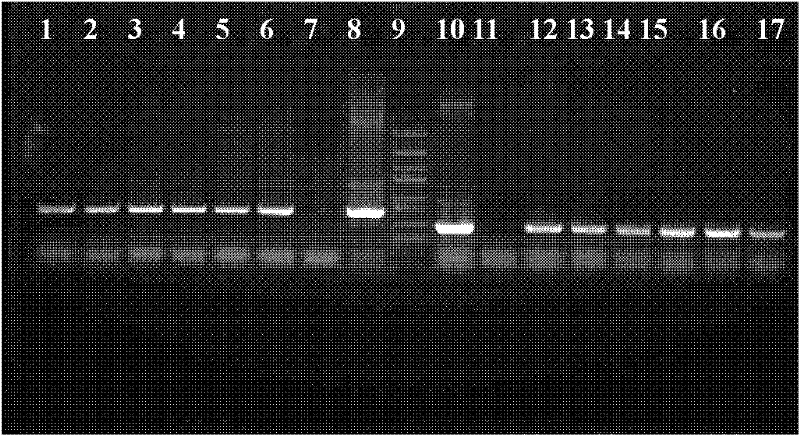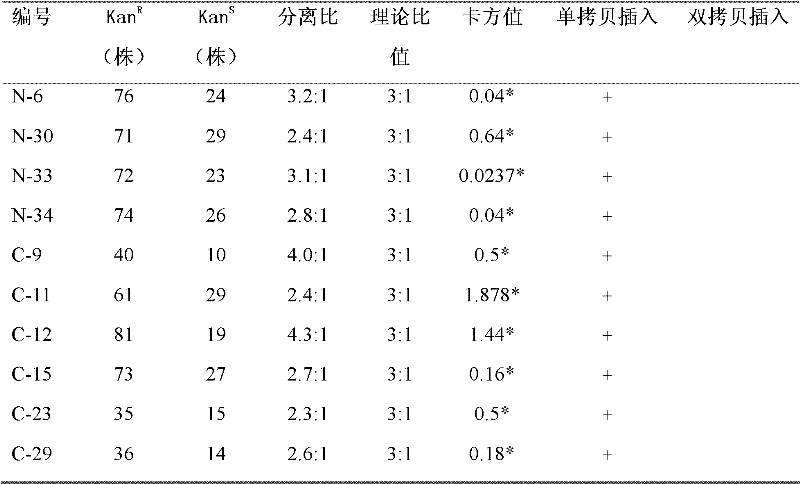Method for controlling transgene flow by using gene split
A gene splitting and transgenic technology, which is applied in the direction of plant gene improvement, botany equipment and methods, applications, etc., can solve the problems of gene drift that cannot be avoided, can not fundamentally solve the problem of gene drift, and achieve the effect of avoiding environmental risks
- Summary
- Abstract
- Description
- Claims
- Application Information
AI Technical Summary
Problems solved by technology
Method used
Image
Examples
Embodiment 1
[0033] Example 1, gene splitting technology limits and controls the gene flow of transgenic G2-aroA gene tobacco (transformation alone)
[0034] 1) Obtaining genetically modified tobacco
[0035] According to the detachable site F295 / T296 of the G2-aroA gene, the G2-aroA gene was divided into N-terminal and C-terminal two parts by PCR method, and connected with the N-terminal and C-terminal of Ssp DnaE intein respectively to form a fusion gene fragment EnIn and IcEc. Transfer the fusion gene fragments EnIn and IcEc into the plant expression vector pG 2 , constructed into EnIn and I C E. C Plant Expression Vectors pEnIn and pI Fused with Gene Fragments C E. C . The constructed plant expression vector gene expression cassette is as follows figure 1 As shown, the exogenous gene is preceded by the chloroplast guide peptide of the Rubisco small subunit, driven by the Rubisco small subunit promoter, the 3' end is the terminator of the Rubisco small subunit, and the screening ...
Embodiment 2
[0050] Example 2, gene splitting technology to limit and control the gene flow (co-transformation) of transgenic G2-aroA gene tobacco
[0051] 1) Obtaining genetically modified tobacco
[0052] According to the detachable site F295 / T296 of the G2-aroA gene, the G2-aroA gene was divided into N-terminal and C-terminal two parts by PCR method, and connected with the N-terminal and C-terminal of Ssp DnaE intein respectively to form a fusion gene fragment EnIn and IcEc. EnIn and I were constructed separately C E. C Plant Expression Vectors pEnIn and pI Fused with Gene Fragments C E. C . The constructed plant expression vector gene expression cassette is as follows figure 1 As shown, the exogenous gene is preceded by the chloroplast guide peptide of the Rubisco small subunit, driven by the Rubisco small subunit promoter, the 3' end is the terminator of the Rubisco small subunit, and the screening marker gene is nptII. Agrobacterium-mediated co-transformation of tobacco to obt...
Embodiment 3
[0058] Example 3: Combining gene splitting technology and chloroplast transformation technology to limit and control transgenic tobacco gene flow
[0059] 1) Obtaining genetically modified tobacco
[0060] According to the detachable site F295 / T296 of the G2-aroA gene, the G2-aroA gene was divided into N-terminal and C-terminal two parts by PCR method, and connected with the N-terminal and C-terminal of Ssp DnaE intein respectively to form a fusion gene fragment EnIn and IcEc. The nuclear transformation vector pEnIn of EnIn and the chloroplast transformation vector pICEC of ICEC fusion gene fragment were respectively constructed. The EnIn was introduced into the tobacco nuclear genome by Agrobacterium-mediated method, and the ICEC fusion gene fragment was introduced into the tobacco chloroplast genome by the particle gun method.
[0061] 2) Obtaining transgenic tobacco containing two gene segments at the same time
[0062] The transgenic tobacco containing the ICEC fusion g...
PUM
 Login to View More
Login to View More Abstract
Description
Claims
Application Information
 Login to View More
Login to View More - R&D
- Intellectual Property
- Life Sciences
- Materials
- Tech Scout
- Unparalleled Data Quality
- Higher Quality Content
- 60% Fewer Hallucinations
Browse by: Latest US Patents, China's latest patents, Technical Efficacy Thesaurus, Application Domain, Technology Topic, Popular Technical Reports.
© 2025 PatSnap. All rights reserved.Legal|Privacy policy|Modern Slavery Act Transparency Statement|Sitemap|About US| Contact US: help@patsnap.com



